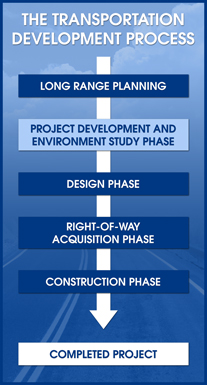A Project Development and Environment (PD&E) Study is conducted to meet the requirements of the National Environmental Policy Act. During the study, we determine the location and conceptual design of feasible build alternatives for roadway improvements and their social, economic and environmental effects. A No-Build Alternative, which considers leaving the roadways in their present state with routine maintenance, remains a viable alternative throughout the study. A PD&E study is finalized when the Federal Highway Administration (FHWA), reviews the documentation and recommendations then provides a Location and Design Concept Acceptance (LDCA). A PD&E Study is required even if federal funds are not used. The Study would need to meet state requirements which are similar to federal requirement in analyzing the effects of the proposed improvements. The state equivalent document is called a State Environmental Impact Report (SEIR) or a Non-Major State Action (NMSA) and the document is signed by the FDOT District Secretary/Delegated Authority or designee. The FHWA would not be involved in this process. If the study results in a Build Alternative selection, the project may proceed to the next phase, which is the Design Phase.
What is a PD&E Study?
Five Steps in the Transportation Development Process
- Long Range Planning: The FDOT and local governments conduct long-range transportation planning on an ongoing basis to identify and prioritize individual projects.
- Project Development and Environment Study (PD&E): During this step, design options and their social and environmental effects are examined. (This is the current step for these I-75 projects.)
- Design: During design, detailed construction plans are prepared.
- Right-Of-Way Acquisition: This phase entails acquisition of necessary right-of-way, based on the construction plans.
- Construction: The roadway is built during this phase.

Upcoming Meetings
The Florida Department of Transportation (FDOT) District 7 will hold a Public Hearing for the US 301 PD&E Study on Thursday, March 24, 2022 from 5:30 pm – 7:30 pm to present the alternatives being considered and allow the public to express concerns and make comments to be included in the project files.
Currently, there are no meetings scheduled. Please check back at a later date for information regarding upcoming meetings.
Contact Information
For more information or to comment, please contact:
Kirk Bogen, PE, Environmental Management Engineer
Florida Department of Transportation, District Seven
11201 N. McKinley Drive
MS 7-500
Tampa, FL 33612
(813) 975-6448
(800) 226-7220
kirk.bogen@dot.state.fl.us
For media inquiries, please contact:
Kris Carson, Public Information Officer
Florida Department of Transportation, District Seven
11201 N. McKinley Drive
MS 7-100
Tampa, FL 33612
(813) 975-6060
(800) 226-7220
kristen.carson@dot.state.fl.us
Comuniquese Con Nosotros
Si usted tiene preguntas o commentarios o si simplemente desea mas informacion sobre este proyecto, favor de ponerse en contacto con nuestro representante, el señor Manuel Flores, al teléfono (813) 975-4248 o correo electrónico manuel.flores@dot.state.fl.us.